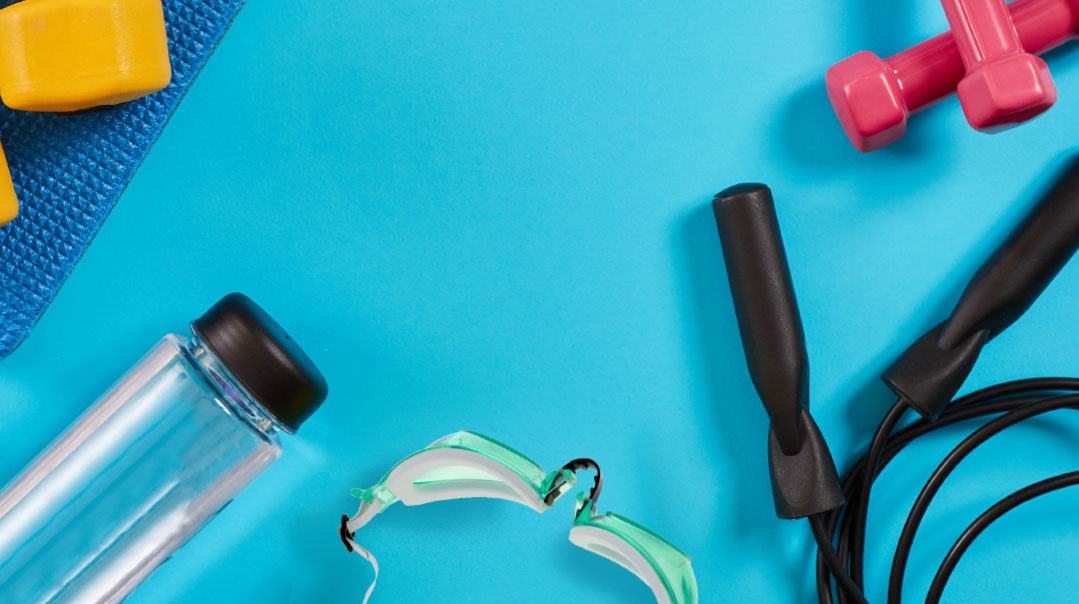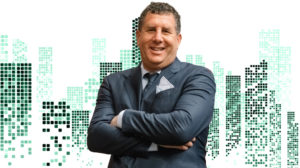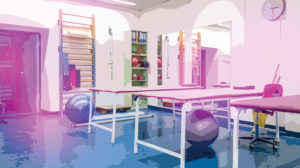So You’ve Always Loved… Movement

Meet five women who’ve found careers that keep them on their feet and in action

Fitness consultant and exercise instructor
Malkie (Raskas) Langer
Experience
$50-$150 per session
Average salaries in field
Salary range is highly variable. A good instructor can charge from $20-$25 per person for a group session, and personal training sessions can range from $50-$150 per session
What a fitness consultant does
I teach exercise — the whole gamut of fitness — and I’m also certified to do weight-management consulting, an added layer that helps me map out a complete healthy fitness regimen.
How I got into this
When I was 19, less than eight weeks before my wedding, I suffered a serious injury. The doctors said there was no way I’d walk down the aisle, and that I may never walk properly again.
I spent hours each day in a friend’s pool, and bli ayin hara, I defied all odds. That’s when I realized the incredible power of water. I decided then that I’d utilize my skill to help other people in the health and fitness arena.
After my wedding, we lived in Baltimore, and someone asked me to give exercise classes. I began teaching in someone’s home, giving classes three hours in a row, three nights a week, and they were packed. Women were just ecstatic!
From there, I opened a full-fledged studio in the JCC in Baltimore with another fitness consultant. Then, 23 years ago, I developed and trademarked a deep water workout called Aqua Tread. People think that working out in the water is for seniors, but Aqua Tread is a real boot camp workout. The Baltimore Sun described my workout as one of the most progressive workouts, and a popular magazine listed it in an article featuring six creative ways to burn fat.
Today, I live in Toronto, where I offer both group classes and one-on-one training.
Hitting the books
When I started teaching exercise, I wanted to be certified, and I wanted the top tier of certification, which was the American Council on Exercise (ACE). People think a fitness instructor just needs to look good and know how to move, but you need knowledge of the body and how it works, how to prevent injury. It’s a big responsibility.
You need to obtain 20 credits of continuing certification every two years, by completing exams or attending seminars. It’s gotten a lot easier to do this — now, you can take exams in fitness magazines and mail them in.
All in a day’s work
I minimize clients before 9 a.m., since I want that time for my family. Then, I may have a private client, and then a small group on either water or land. The number of clients I train has varied over the years from between 30 to 50 per week.
I also see clients for weight-management consultation. With generic diets, you usually see results — but they usually don’t last. You need to figure out what’s appropriate for each person, from a child to a nursing mom to a senior. Ideally, you should couple a personalized diet with a fitness regimen, burning calories with exercise.
There’s always preparation — finding music, choreographing classes, planning my next program. All the exercise is done to music, so I need to create playlists depending on the age group and background of the clients. I need to stay current and change things up so there’s always that element of freshness.
Of course, in between there’s administrative work. I get e-mails and phone calls throughout the day. I do all of my own bookkeeping. I may need time to formulate ads and take care of advertising.
Memorable moment
I volunteered for Gevuras Yarden, an organization that helps people with illness. I went to help a woman who’d been told she had only a few months left to live. A woman who was beautifully dressed and made up opened the door. I said, “Hi, is Aliza home?” She said, “I’m Aliza.”
I said, “Why are you dressed for a party? I’m your exercise teacher!”
She said, “What if Mashiach comes when we’re in middle of a class? I need to look beautiful.” That’s stayed with me ever since. Aliza died four months later. She was so weak and frail, she had every reason to be curled up in a fetal position, yet look at her tzipisa l’yeshuah!
It’s so incredible what challenges people are faced with. Without their jewelry or fancy clothes, the mask is off, and we see who they really are. I am able to connect with all types and ages of people. What I gain is so much more than what I give.
Why I love my job
I’ve never looked at this as a job — I love, love, love what I do! I always thought I’d be Ms. Career Woman, but this has been an unbelievable career without downsides.
It’s so stimulating. It’s not just choreographing or creating movements; you’re also mentally challenged. People come in with all sorts of clinical conditions or histories — I need to know if they’re pregnant or postpartum, if they’ve had any injuries, allergies, food aversions, if they’re asthmatic — and I need to make sure I’m helping them appropriately.
Once you have a following, it’s a phenomenal career. You can work as full-time or part- time as you want, and you can be there for your family. And it’s so portable; I’ve lived in three countries and have done Pesach programs all over the globe.
The range is exponential. If you have a big space, you can teach classes of 15–20 people at $15–25/person.
You should know
You need a thick skin! At a kiddush or seudos people make all sorts of comments — “Oh, I’m sure you don’t eat dessert.” Of course I do, I’m a normal human person!
Or people assume that because you’re a fitness consultant, you must have no depth. The world out there objectifies women — if they see a pretty face and thin body they don’t think beyond that.
You’d make a good fitness consultant if you’re
Active, on the go, a people person. You definitely need to be very social, but you also need to have a good business sense. It’s also obviously a great way to stay in shape!
Not in Vain
It’s not about working with vain women who just want to look good; it’s much deeper than that. There are so many health benefits to exercise, both mental and physical. Exercise is a happy pill.
We daven and eat every day; there should be time for physical activity too. HaKadosh Baruch Hu wants us to take care of our bodies — it’s not frivolous, selfish, or vain to engage in self-care. On the contrary — you’re a mother, grandmother, sister, daughter, aunt, to so many people. If you don’t take care of yourself you can’t take care of them.
Doula and Childbirth Educator
Sarah Sragg
Years experience: 23
Average salary in field $20–$50 depending on number of classes and clients
What a childbirth educator does
I give a childbirth education class with Lamaze theory. It covers what to expect during labor and delivery and immediate postpartum — not just info on the birth process, but how to cope emotionally and physically. As a doula, I accompany women and help them throughout their labors. I also offer support to their husband/labor partner.
How I got into this
I was working in computers for HP and totally burnt out from the long hours in my field. When I attended a birth refresher course before I had my second and third babies, I decided I’d love to learn more. They said, “Oh, you’ve had three natural births, you’ve taught computers, you’ve done sales, you’re a people person — you can do Lamaze.”
I got my Lamaze certification as a childbirth educator first, and taught group classes and private classes for a couple years, then I went to a training to get continuing education credits.
(You need to gain thirty continuing credit hours every three years to recertify.) I hadn’t realized this training counted toward certification as a labor doula, but I came back from the training thinking, whoa, I want to do this. I started slowly, supporting people in the community without charging, and then I got my certification.
Hitting the books
Lamaze certification can take anywhere from about six months to a year. You need to attend formal seminars, then you write your own curriculum and teach a class with a mentor, who watches you and critiques the lesson. There’s also a multiple-choice certification exam, which questions on obstetrics, teaching strategies, and people skills. Not having a nursing or medical background made it a bit more challenging.
To become a doula, there’s some self-study reading, training seminars to attend, and then you need to act as a doula and get evaluated by nurses, doctors, midwives, and clients.
All in a day’s work
I teach one or two nights a week, and it’s a four-week series. I have an extra week buffered into my scheduling, so that if I need to go to a labor, I can just postpone the class for a week. During a typical week, I teach one or two classes.
I also meet with my doula clients — I usually meet with them twice before the birth, typically on an evening or Sunday, since most people work. We meet for one to two hours, and they ask me questions about my role, the hospital setting, when to call me.
The earlier you meet with me, the more support you get, since I offer unlimited phone support — clients often email or text me with questions. I like to meet again for a prenatal consultation three to four weeks before they’re due.
We usually meet in the client’s home, since I like to do some more practical exercises, almost like we’re role playing labor. It’s important to practice in their own environment so that when it’s real, they can be in their own comfort zone. The more progress they can make at home, the better.
Most labor doulas don’t teach, and most childbirth educators are not on call. I do both, but I manage by doing a weeknight series, not a condensed all-day class. I also do a lot of private classes for the frum community; frum couples tend to like private classes.
Why I love my job
People ask me, “How can you spend over 24 hours with a client?” But witnessing birth is probably the most incredible neis you can ever see. My awe doesn’t decrease with time — every birth is so special.
Being a labor doula is truly a passion; not everyone can do it. You’re in it to the end. I’ve been exhausted, but I will never leave. It takes me a couple days to recover completely from a birth. The difference between me and the new mom and dad is that I can come home and crash!
Wish I’d known
If I’d known when I was starting what I know now, I probably would have received a nursing degree and become a midwife, or maybe even gone to medical school. But I’m not going to look back and say, “I should have done this, I should have done that.” I really love what I do!
You’d make a good doula if you
Have a lot of patience. You also need to have a lot of stamina. I’ve always exercised and stayed in shape.
You have to have a very calm and even disposition. I’m assertive, but not in an aggressive way. You need to support women in labor while being understanding of the medical staff; I’m not going to go head to head with medical support. I am there to support my client and make the medical staff’s job easier.
I also think you need to be soft, not loud and hyper. Labor can get people anxious; you need to keep everyone calm.
Shemiras Shabbos
The rav of my community, Rav Kalman Winter, a”h, told me that I could support frum couples on Shabbos, since it’s not just a job, it’s also a chesed. He told me that I can go to the hospital (with the couple or by taxi), but that once I’m at the hospital I can’t leave unless I walk back, so I made the decision that I’d only be on call for frum couples delivering locally.
I have a backup for all of my non-Jewish couples — it’s a lot of juggling! The majority of the clients I work with aren’t Jewish, so in our first conversation I tell them that I’m not on call one day a week, and that I work with a backup.
Dance Teacher
Michelle Penn
Years experience: 5:
Average salary in field: $20-$30 per teaching hour, depending on enrollment and experience
What a dance teacher does
I run a dance studio that offers professional-level dance lessons to girls — I teach, and have other teachers working for me as well. I’m also the only administrator, and run this program myself.
Hitting the books
I’m a baalas teshuvah, and I was fortunate enough to grow up with some serious dance training. My mom put me in dance classes when I was three years old, along with everything else — swimming, diving, gymnastics — but dance is what stuck. I graduated college with a degree in dance and psychology. My coursework included classes in dance education and dance administration.
In my junior year, I decided to take an internship in Chicago working with an amazing, world-renowned dance company. I learned super hands-on skills about the administrative side of dance. This was a very major step in my future career — I realized that all these gorgeous, world-class productions came together by some very normal people sitting around a table and making decisions.
This internship is also where I realized that I didn’t want to become a professional dancer. These dancers, who were literally some of the best dancers in the world, weren’t happy — and if they weren’t happy, who would be? That summer, I started to find Torah and mitzvos. I went on a MEOR Israel trip, which was an amazing experience, and there I saw meaning, drive, and purpose that I felt had been missing in the worlds I’d been inhabiting until that point.
After I got married, I moved to Silver Spring. I had no intention of being a dance teacher; I loved dance and performing, but I didn’t think I’d love the teaching element of it. But all these women started asking about classes for their kids. It started to feel like I was being selfish — if Hashem had given me this talent and knowledge, shouldn’t I share it? We had 45 girls sign up right off the bat. Clearly, there was a need for this.
All in a day’s work
I’m constantly juggling my roles as a mother, wife, teacher, and administrator. I’m home with my toddler, so during the day, I spend time with her. I’ll make calls while I take her for a power walk through the neighborhood, then I do computer work while she naps. When I’m in the playroom, I may do some basic choreographing or a warm-up —something that doesn’t require too much brainpower, so that I can still be interacting with her.
I spend an inordinate amount of time trying to find music that the kids will enjoy, that’s still appropriate for our clientele — we only use Jewish music or music without lyrics. Then there’s class prep. I have a curriculum, just like any normal school, and it includes what I want to teach for each age, group, and style. At about 3 p.m., I head out to go teach dance, and a babysitter takes over.
Up until now, we’ve been working out of schools and shuls. But the need is there, so we’re in middle of building a new dance studio. Once we have our own space, I hope to grow our class offerings even more to include adult dance and fitness classes, and new styles like tap and contemporary.
Memorable moment
I’m asked to speak a lot, and every time I tell my story to FFB girls, they’re like, “Oh, this is so amaaazing!” I don’t feel like I’m so amazing, but it reminds me each time of how much siyata d’Shmaya I’ve had in getting to where we are.
What I’ve learned from their reaction is how uniquely empowering one person’s drive can be. I feel like I’m clearly doing what I’m supposed to be doing. It’s a tremendous blessing that Hashem brought me to Yiddishkeit, for so many reasons, and I’m so grateful to be able to bring girls really high level art that they wouldn’t be getting otherwise.
Why I love my job
I’ve surprised myself by how much I love teaching. It’s so incredible to see how I’m making a difference, and to watch the girls grow and improve, as dancers and as people.
Other people have told me how nice it is that I give girls who aren’t so academic the chance to shine. I can’t attest to that, since I don’t know who shines scholastically — and I think that’s a good thing! — but I really appreciate the parents and teachers who tell me this.
Wish I’d known
It’s hard teaching after-school hours and missing those afternoon hours with my kids, especially since my son just started kindergarten. When I started, he was a cranky baby and I was so ready to get out. I figured I’d teach for a few years then stop, but I had no idea how it’d take off, which I’m so grateful for. But now I just need to strike the right balance for me, my family, and the community at large.
You’d make a good dance teacher if you:
You need real training to teach dance. I think there’s this fallacy in the frum world that if you watch a few videos or took a few classes, you can open a dance school. When I think about that, I shudder — there’s so much that goes into proper training! I don’t want to say formal professional training is a prerequisite; but you do need a significant amount of training and to work really hard. Im yirtzeh Hashem, I hope my students will be able to teach dance! I’d love to expand and bring my program to other communities.
All in the Drive
Dance is a skill that can be learned by anyone, but some people have a greater predisposition to the skills important to dance, like musicality, flexibility, or the mind-body connection that helps to pick up information and translate it into their own bodies.
I often tell my dancers that I have videos of myself dancing when I was three years old, and the funny thing is that you don’t see a difference between me and the next girl. The only difference is that when it got hard and tiring — I stuck with it.
Chiropractor
Chani Milstein
13 yrs experience
Average salary in field: 70,000–90,000
What a chiropractor does
Every part of the body has its corresponding part of the brain. If one area in your body isn’t working properly — which can present as pain or decreased movement — its brain counterpart isn’t working properly either. We teach people movement vocabulary. The more movements you make, the more changes you make to the brain.
We learn skills through movement, not by sitting down with a book. Take a special needs kid and give them the experience of turning their head or shifting their pelvis; if previously they’d only moved 90 degrees and you have them move 180 degrees, that’s a whole new world for them. Their life will be different because you helped them increase their movement.
Hitting the books
If you’re going to be a chiropractor, you have to really want to do it; it’s not at all practical. There are less than 20 chiro programs in the US, and only two are on the east coast. The schooling was intense. You get anatomy, nutrition, biochem, you work on cadavers — it’s a lot of the same things as medical school. Classes were from 8 a.m. to 6 p.m. every single day. Then there’s a year of clinicals, which is like a medical residency.
It was a big culture shock. I’m a Bais Yaakov girl, but here I was the only frum person on campus.
Even now, I need to get 30 credits every two years to renew my license. Every state has its own requirements.
At first, I had a very hard time finding a job. Many people want to visit the chiropractor on the weekend, and when you start as an associate, they want you taking bad hours, like Friday night. As soon as potential employers found out that I was frum, they didn’t want me. It took me a long time till I found a frum office. That’s just the nature of the job.
All in a day’s work
I work with all ages, from babies on day one to people in their nineties. I do sports chiro, rehabilitation, some cranial work. People often come to me as the last step before surgery, after they’ve been trying alternative therapies months. I often say that I come in after the patient has received a clear X-ray or MRI, but is still experiencing pain that hinders their daily function. I offer them opportunity and hope.
I also get typical run-of-the-mill requests — let’s say a kid has recurring ear infections, I do cranial work and chest work to move fluids around.
My real niche is an approach called Movement Lesson. When my now three-year-old was an infant, I realized he wasn’t meeting developmental milestones. I did a lot of research and found Michelle Turner, who developed this technique to help her kid who had special needs. The technique speaks to me as emes; it gets to the source.
Movement Lesson focuses on experiencing gravity correctly, which is extremely important. Infants don’t have a gravitational field until they’re expelled. If there’s a problem during the birth process, they don’t have proper system mechanics in relation to gravity. So let’s say the baby had an IV on their right leg or they were born via C-section, then their brain won’t get the benefit of certain movement. This lack of brain activity equals lack of cognition.
The idea of the technique is to give these kids a little help initially, to help them go through different movements, so they don’t need early intervention programs, so they don’t develop all those acronyms.
Memorable moment
I flew down to meet Michelle Turner so she could treat my son. After four hours with her, my son (who was almost two) got up and walked for the first time! It was incredible.
Why I love my job
It’s extremely rewarding — you help people, hands-on, and they tell you how you changed their life.
The nice thing about chiropractic is that whatever your interest is — sports, nutrition — you can bring it in. You have credentials behind your name, you brand yourself, and if you can provide what your patients want, then you’re good.
Since I have a home office, I make my own hours, and I can work whenever I want while still being available for my family.
I don’t do injuries or work through insurance, it’s too much paperwork for me at this point. I could hire someone to do the billing, but then I’d be working more hours to pay someone else’s salary. I’d rather make less and spend more time with my kids.
I wish I’d known
How unreliable reimbursement is (which is why I no longer take insurance).
Over the years, insurance reimbursement has declined: If JerseyCare covers the treatment, I get $24 for the first visit; subsequent visits are $8, because chiropractic is not considered medical care. Medicare is four bucks — you can’t pay off 140,000 in student loans that way!
You’d make a good chiropractor if you
Can think in 3-D. You need to love anatomy and movement and physiology; you should want to know the body in and out.
Bare Bones
I’m able to work in the dark; everything is through touch and feel. You can feel glitches in the system, areas where you can’t rotate, areas where there’s more friction in the body or you feel pain. I don’t need equipment, either: I have a table and my hands. It’s very bare bones, but I don’t need more than that — the kuntz is my hands.
Hydrotherapist
Chavi Traube
Years experience: 5
Average salary in field in UK: between £40 and £70 an hour
What a hydrotherapist does
In simple terms, hydrotherapy is like physiotherapy in water. Water takes the edge off the pain. There may be many things that a patient cannot do outside of the water — picking up her hand, walking — but she can achieve that in the pool.
I work with kids and adults of all ages — my youngest patient was six months old, the oldest was 80. Babies come in when they’re late developers, or if they have low muscle tone. People may come in after injuries or surgeries — like a broken shoulder, hip, or knee — or for rehabilitation. Older people come in with their aches and pains, for arthritis or stiffness, and to reduce pain.
How I got into this
I’ve been swimming since I was very young, and I always loved water. I wanted to teach swimming, but most programs are mixed. I learned that there was a therapy that takes place in the water, and while all of the training programs in England were mixed, I found that there were programs appropriate for frum women in Eretz Yisrael. I decided that I’d move there after I got married, go for training and gain experience, and then move back.
Hitting the books
It took about one and a half years; I went to a program in Bnei Brak offered through an internationally recognized university. At first, I went to class once a week for ten hours, four of which were spent on theory and the rest was practical, in an on-site pool. Once we were working and getting experience, we spent a few times a week in different places. We needed to get a compulsory 40 hours of hands-on training. We were assigned to an experienced hydrotherapist who gave us clients and watched how we did everything.
In class, we learned the theory: how the parts of the body worked, anatomy, neurology. For me, it was doubly hard since it was in a new language. I had basic Hebrew skills, and the teachers were very nice. We had an exam every four weeks, and at the end we had one major one for certification.
All in a day’s work
I rent a heated pool and offer half-hour sessions — I don’t do longer ones because otherwise it’d be too much for the client. You don’t chap how hard you work until after you come out of the pool, completely exhausted. So I’m in the water and people come in, one after the other, all ages. I usually don’t work more than three hours at once, since it’s very tiring — and working in a hot pool is doubly so.
Each person is completely different — their age and stage, how long it is after surgery… Obviously, the sooner you come after surgery, the better. When they come in, we create goals — maybe they want to walk without tiring, they want reduced pain, they want to be able to carry heavy things. People usually see a difference after just a few sessions. I advertised once when I started — since then, it’s all been word of mouth.
Memorable moment
There’s no one person who stands out, but whenever I can help someone who comes in completely disabled and walks out completely okay, it’s an incredible feeling. I’ve had quite a few of those experiences. I’ve also had kids who come in with quite a few problems, and their mothers have told me that one by one, they’ve all gone away, and their child’s confidence has boosted.
Why I love my job
I love working with people and seeing the results, how someone comes in with a stick and can walk out without one. There’s so much satisfaction. I also love working with water.
Wish I’d known
I didn’t think there would be so much theory in the schooling, but now that that’s all in the past, I enjoy every minute of it.
You’d make a good hydrotherapist if you
Enjoy working with people. You need a lot of patience — you don’t see results the next day, but you do see improvement from one session to the next. And of course, you need to enjoy being in the water. You don’t need to know how to swim, though — sessions usually take place in shallow heated pools.
Special Benefits
In Eretz Yisrael, I did a lot of work with children with special needs — hydrotherapy is much more common there, and it’s a part of the special ed schooling. I’d see them put these helpless kids in the water, and they’d suddenly come alive, they’d be able to move and walk around. It amazed me every time.
(Originally featured in from Family First, Issue 666)
Oops! We could not locate your form.













